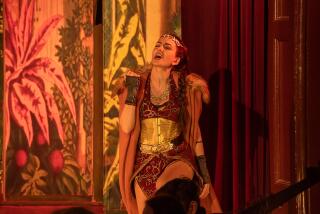A âTinaâ Taken Out of Time and Context
From her career as a Hollywood silent film actress through a period as a photographer belonging to a circle of major contemporary artists living in Mexico--and on to her role as a political activist with vital responsibilities in the Communist Party throughout Europe--Italian-born Tina Modotti seized the new freedoms for women in the early 20th century with unprecedented daring.
Unfortunately, Modotti the artist, the firebrand, the proto-feminist, remains marginal in âTina,â a misguided tribute in speech and song by composer-librettist Andrea Centazzo. Centazzo calls it an opera but it more closely resembles an oratorio: reverent, static and innately nontheatrical despite transfusions of film imagery and contemporary dance.
Originally presented two years ago by the Teatro Comunale âG. Verdiâ of Trieste, âTinaâ received its American premiere on Saturday in the Freud Playhouse at UCLA, conducted and directed by the composer. Marcos Lutyens created a set resembling an antique camera, and in its lens appeared black-and-white photographs and motion pictures of Modotti, her changing environments and the social unrest shaping her life. The costumes of Krizia and lighting of Claudio Schmid reinforced the black-and-white emphasis, while Centazzoâs staging relied on dark, stultifying tableaux periodically relieved by five members of the Dance Studio Ensemble of Bologna performing the mostly dry, clockwork choreography of Luis Bernardo Ribeiro.
A strong cast gave voice to Modottiâs saga in curious isolation, without ever interacting dramatically. Actress Lumi Cavazos, of âLike Water for Chocolate,â soulfully spoke the English text drawn from Modottiâs letters. As her singing surrogate, soprano Francesca Ziveri forcefully negotiated Centazzoâs declamatory ariosos with their push-button high notes. Baritone Fulvio Massa adroitly shaped his rich if grainy vocalism to contexts both personal and social in Modottiâs story. Members of the Los Angeles Contemporary Orchestra made the textures in the score extraordinarily vivid, with the xylophone especially prominent.
*
And none of it mattered, not one bit. For Centazzo had pared away nearly everything that his subject achieved in her remarkable life and reduced her complexity to droopy lovesickness: Modotti longing for photographer Edward Weston and telling him so in letter after letter, recitative after recitative, arioso after arioso. In the process, Centazzo not only trivialized Modotti but undercut himself, because his talent for propulsive ostinatos and orchestrations dominated by brass and percussion proved more suited to the active, martial Modotti who was largely excluded from âTinaâ than the doleful simp emerging in her place.
Puccini might have put over this sentimental portrait of a lovelorn innocent who foments revolution between letters to her boyfriend. But Centazzo has no such gift for lyricism and, anyway, 102 years after Modottiâs birth, something more pithy and pertinent is required. Something like âTina Modotti Is Dead,â the Pablo Neruda poem that Centazzo appropriates for a prologue but fails to incorporate conceptually.
âA world marches to the place where you were going, sister,â Neruda wrote, never mentioning Weston or anything about Modottiâs personal life. âThe songs of your mouth advance each day in the mouths of the glorious people that you loved.â
Sadly, âTinaâ sings those songs only once, in an ode to freedom too brief and too early to make any real difference.
More to Read
The biggest entertainment stories
Get our big stories about Hollywood, film, television, music, arts, culture and more right in your inbox as soon as they publish.
You may occasionally receive promotional content from the Los Angeles Times.










